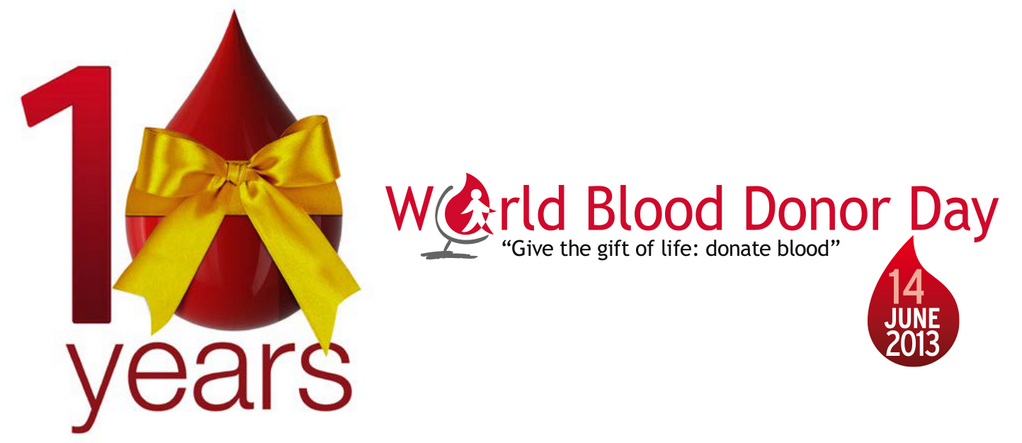
World Blood Donor Day & Importance of Blood Donation
.
Transfusion of blood and blood products helps save millions of lives every year. It can help patients suffering from life-threatening conditions live longer and with higher quality of life, and supports complex medical and surgical procedures. It also has an essential, life-saving role in maternal and perinatal care.
However, in many countries, there is not an adequate supply of safe blood, and blood services face the challenge of making sufficient blood available, while also ensuring its quality and safety.
An adequate supply can only be assured through regular donations by voluntary unpaid blood donors. WHO’s goal is for all countries to obtain all their blood supplies from voluntary unpaid donors by 2020. Today, in just 62 countries, national blood supplies are based on close to 100% voluntary unpaid blood donations, with 40 countries still dependent on family donors and even paid donors.
The focus for the 2013 campaign – the 10th anniversary of World Blood Donor Day – is blood donation as a gift that saves lives. WHO encourages all countries to highlight stories from people whose lives have been saved through blood donation, as a way of motivating regular blood donors to continue giving blood and people in good health who have never given blood, particularly young people, to begin doing so.
The objectives of this year’s campaign are to thank blood donors for their life-saving donations; promote voluntary unpaid blood donation; and convince ministries of health to commit to achieving self-sufficiency in safe blood and blood products based on 100% voluntary unpaid blood donation.
What is blood?
One can almost say that blood is that magic potion which gives life to another person. Though we have made tremendous discoveries and inventions in Science we are not yet able to make the magic potion called Blood. Human blood has no substitute. Requirement of safe blood is increasing and regular voluntary blood donations are vital for blood transfusion services.
Who can donate blood?
Eligibility criteria for blood donation :
Donor should be between 18-55 years of age with a weight of 50 kg or above with pulse rate, body temperature and blood pressure should be normal. Both men and women can donate. There are only few conditions in which donors are permanently excluded. The donor with history of epilepsy, psychotic disorders, abnormal bleeding tendencies, severe asthma, cardiovascular disorders, malignancy are permanently unfit for blood donation. Donors suffering from disease like hepatitis, malaria, measles, mumps, and syphilis may donate blood after full recovery with 3-6 months gap. Also people who have undergone surgery, blood transfusion may safely donate blood after 6-12 mths for woman donors who are pregnant or lactating blood is not taken as their iron reserves are already on the lower side.
How much blood can be taken?
Our body has 5.5 ltr of blood of which only 350 ml – 450 ml of blood is taken depending upon weight of donor. Majority of healthy adults can tolerate withdrawal of one unit of blood. The withdrawn blood volume is restored within 24 hours and the hemoglobin and cell components are restored in 2 months. Therefore it is safe to donate blood every three months.
What is done with the blood collected?
The blood collected in sterile, pyrogen free containers with anticoagulants like CPDA or CPDA with SAGM. This prevents clotting and provides nutrition for the cells. This blood is stored at 2-6 C or -20 C depending on the component prepared. Donated blood undergoes various tests like blood grouping antibody detection, testing of infections like hepatitis, AIDS, Malaria, syphilis and before it reaches the recipient it undergoes compatibility testing with the recipient blood.
Modern Blood Transfusion Practice:
Modern blood transfusion basically deals with the optimal use of one unit of blood. One unit of whole blood is separated into components making it available to different patients according to their requirement. Thus one unit of blood is converted into packed cell volume, fresh frozen plasma, platelet concentrate, cryoprecipitate and granulocytes concentrate. Another important practice is apheresis. This is separation of only desired component from the donor and return the remaining constituent back to donor. This technique is also used for remaining pathological substance in patients. Withdrawal of blood for transfusion is regarded as a safe procedure now and blood donor has emerged as the single most vital link.
Blood Donation and its Advantage ::
Blood donation, the voluntary act of allowing one′s blood to be drawn out of body has many advantages. No doubt the first and foremost advantage of donating blood is the exalted feeling of saving someone′s life. If we donate the little excess blood in our body, it could save someone′s life without creating any problem for us.
The average amount of blood present in an adult is 4-5 liters or about 8% of the body weight. Life cycles of the different components are short. The RBC lives about 120 days while white cells last about 3-9 days. New blood cells are constantly generated in the body. A person can donate blood 168 times during his 18 to 60 years. The quantity of blood present in 1kg of body weight is 76ml for males and 66 ml for females. Out of this 8 ml per kg body weight can be donated. Males can donate for every three months while females for every four months. All donated blood is recuperated within 21 days. At one time only 350 ml will be taken from a donor.
Blood donation is harmless and safe in the body.
Rather, it is a social responsibility. The donor is donating for it as it will be used in saving lives of his fellow beings. He himself may use the same in his own need. So today’s donor may be tomorrow’s recipient.
The whole process of blood donation – from the time you arrive until the time you leave – ordinarily lasts no more than one hour. The donation itself takes only about fifteen minutes. Your single donation can help as many as three people, and can be at a hospital in as little as 48 hours, ready for a critically ill patient.
Blood donation also burns the extra calories and reduces your cholesterol level.
After donating blood, the count of blood cells decreases in our body, which stimulates the bone marrow to produce new red blood cells in order to replenish the loss. So, it stimulates the production of new blood cells and refreshes the system.
In times of accidental injuries that shed huge amounts of blood and also in various types of surgical operations for medical treatments, blood is required for transfusion. Unavailability of blood may cost lives. Hence, importance of blood donation is tremendous. This is the greatest gift one can do for the mankind.
There are no major disadvantages of donating blood, except that sometimes one may experience a drop in blood pressure or mild nausea or dizziness for a short while. But if you compare the health benefits and mental satisfaction that comes from saving a life, you will feel that benefits of this act of charity are not only restricted to the recipient, but also helps the donor immensely.


